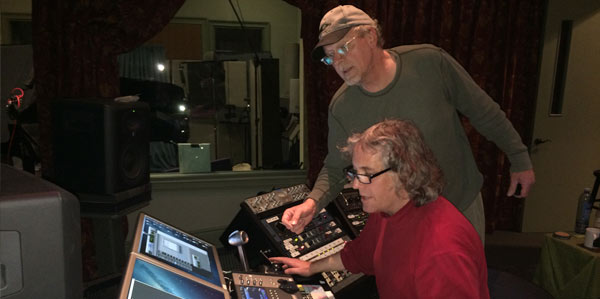Old Dogs New Tricks
Robert Margouleff, Grammy nominated audio engineer famous for introducing Stevie Wonder to electronic synthesizers and working on “Talking Book” and “Innervisions”, asked me to be part of a recording project that he’s working on with songwriter Paul Horner. Last Tuesday evening, it took place at Michael Boddicker’s home studio in Encino, California, which is a topnotch facility with a full film mixing control room and an iso booth with a Yamaha 7 foot grand piano. This is not your average “home” studio.
Michael has been one of the go to keyboard players in Los Angeles for over 30 years. I wanted to reintroduce myself to him after almost that long. In 1983, I attended a presentation that he gave on the newly introduced DX-7 synthesizer, the first to use FM as the basis for its sound engine (which was invented by John Chowning of Stanford University). Michael had figured out the DX-7 and gave a lecture on programming the beast. I was also interested in hearing him talk about recording synthesizers in the studio.
Audio engineers tend to use something called a Direct Box (aka a DI box for “direct inject”) whenever they need to capture the output of an electric guitar or synthesizer. A DI box takes the high impedance, unbalanced, instrument level signal from a “phone jack” and converts it to low impedance, balanced, microphone level so that it can be connected to the mic preamps of the recording console. There are obvious advantages to going “direct”. The talent can play their parts in the control room (listening through the big monitors as opposed to headphones) because there are no mikes used and the there is no interference.
But many musicians, especially guitar players, want the engineers to capture their “special” sound as it comes out of the speaker cabinet. So a couple of microphones are placed in front of the cabinet, which is located in the studio or an iso booth. But most synthesizer players…especially back in the 80s…went direct. Michael Boddicker didn’t. He insisted that the engineer record the output of his amplifier with microphones so that the sound would “breathe” the air. It made sense to me.
I drove to the valley and got there about an hour late. Robert and Michael had already set up the microphones around the piano. There was an MS (Mid Side pair), a couple of spaced omnidirectional mics about 6 feet back from the instrument, and a couple of large diaphragm AKG-414 inside the instrument…just above the strings. Robert asked me to come to the session because he had heard some of my piano recordings and liked them. He especially liked the “stage” perspective 5.1 surround mixes…the ones that wrap around the listener.
He asked me what I thought of the microphone set up. I certainly didn’t want to tread on anyone’s toes…certainly not these guys. They have more experience than I do…but there was a reason why Robert wanted me there. I politely suggested that they wouldn’t be able to get a surround mix using traditional stereo miking techniques and that I use two stereo pairs inside the instrument. I’ve talked about this before (read here). Some traditional engineers have said things like, “when was the last time you listened to a piano with your head inside it?” Well, I’m not going to rehash that issue…I have my reasons and they work.
I left the session about 7 pm after they had a couple of tunes in the can. Robert called me the next day and was over the moon about the results. Apparently, they did some listening through Michael’s big theatrical surround system in the wee hours Wednesday morning and everyone was amazed at the sound…the immersive surround, the tone, the presence, and details that came out of the tracks. Robert was very complimentary and told me that I had taught an old dog a new trick.
He made my day.
+++++++++++++++++++
I’m still looking to raise the $3700 needed to fund a booth at the 2015 International CES. I’ve received some very generous contributions but still need to raise additional funds (I’ve received about $3300 so far). Please consider contributing any amount. I write these posts everyday in the hopes that readers will benefit from my network, knowledge and experience. I hope you consider them worth a few dollars. You can get additional information at my post of December 2, 2014. Thanks.

